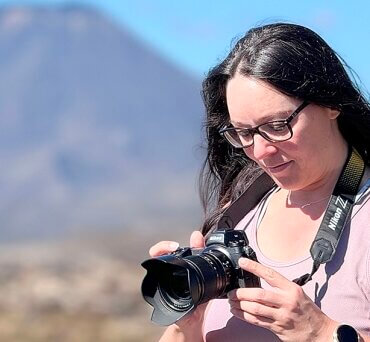
Janine Krippner
Our planet has the incredible ability to create new parts of itself. Volcanic eruptions occur when material from deep within the Earth rises and forms new landscapes. Islands are built this way, layer by layer, over timescales difficult to grasp.

Janine Krippner checks her camera settings while on volcano watch. Photo: Drew Mehrtens.
We can watch rock flow. Molten rock that creeps, or races, across the ground, then cools and solidifies into new forms. When this happens near the coast, lava deltas stretch the land into the ocean. The Earth is constantly reshaping itself.
For many of us, volcanic eruptions are mesmerizing, exciting, and beautiful. The raw power and destructive beauty can be captivating. But what happens when it unfolds right above our communities?
It is now four years since the start of the La Palma (Tajogaite) eruption, and for three years this has been one of my research focuses. On September 19, 2021, a new vent opened uphill of populated areas. In the first moments it was just a small ash plume as the forces blasted rock into the air. New vents rapidly opened, forming a fissure.
Then the lava came.

Janine Krippner
I’ve spent countless hours watching footage of the eruption, seeing how the lava carved its path across the landscape. I’ve watched it consume homes – people’s homes. Family homes containing children’s bedrooms and precious abandoned toys. I have walked around those damaged or destroyed along the boundaries. No one knew their lives would flip upside down in a matter of minutes. Some had 15 minutes to grab what they could before leaving, many never to return.
Our world faces many natural hazards. Here, we’re familiar with floods, cyclones, tornadoes, earthquakes, and the threat of tsunamis. But there’s something distinctly different about this eruption style.
Lava flows don’t just damage or destroy. Lava cools into rock, sometimes reaching tens of metres thick. Floods may take a house, but they don’t leave the landscape itself unrecognisable. In La Palma, entire communities were buried.
The evacuation and loss of home is just one part of the struggle. The road to rebuilding a life after such a disaster can stretch over years. The mental toll can be immense. The human side of these events, the pain, the grief, the trauma, is something most of us can’t fully understand unless we live through it. And yet, it is the most important aspect for us to grasp.
On this fourth anniversary of the eruption, I am thinking of those people. This kind of disaster will happen again. Those who will one day lose their homes and communities are most likely unaware of the risks they face or at least can’t truly grasp that it could happen to them.
As a volcanologist and science communicator, I constantly wonder what I can do to help those who will be affected. What lessons, however agonising, need to be passed on to mitigate the pain? How can we prepare not just with science, but with humanity, to help people not only survive but rebuild their lives after the ground beneath them is forever changed?
It is up to us how we prepare to face the human cost when the ground beneath us shifts, and how we ensure that, in the aftermath, no one is left behind.








